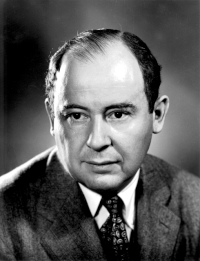
Photo from wikipedia
Evolution consists of distinct stages: cosmological, biological, linguistic. Since biology verges on natural sciences and linguistics, we expect that it shares structures and features from both forms of knowledge. Indeed,… Click to show full abstract
Evolution consists of distinct stages: cosmological, biological, linguistic. Since biology verges on natural sciences and linguistics, we expect that it shares structures and features from both forms of knowledge. Indeed, in DNA we encounter the biological "atoms", the four nucleotide molecules. At the same time these four nucleotides may be considered as the "letters" of an alphabet. These four "letters", through a genetic code, generate biological "words", "phrases", "sentences" (aminoacids, proteins, cells, living organisms). In this spirit we may consider equally well a DNA strand as a mathematical statement. Inspired by the work of Kurt Godel, we attach to each DNA strand a Godel's number, a product of prime numbers raised to appropriate powers. To each DNA chain corresponds a single Godel's number $G$, and inversely given a Godel's number $G$, we can specify the DNA chain it stands for. Next, considering a single DNA strand composed of $N$ bases, we study the statistical distribution of $g$, the logarithm of $G$. Our assumption is that the choice of the $m$-th term is random and with equal probability for the four possible outcomes. The "experiment", to some extent, appears as throwing $N$ times a four-faces die. Through the moment generating function we obtain the discrete and then the continuum distribution of $g$. There is an excellent agreement between our formalism and simulated data. At the end we compare our formalism to actual data, to specify the presence of traces of non-random dynamics.
Journal Title: Physica A: Statistical Mechanics and its Applications
Year Published: 2022
Link to full text (if available)
Share on Social Media: Sign Up to like & get
recommendations!